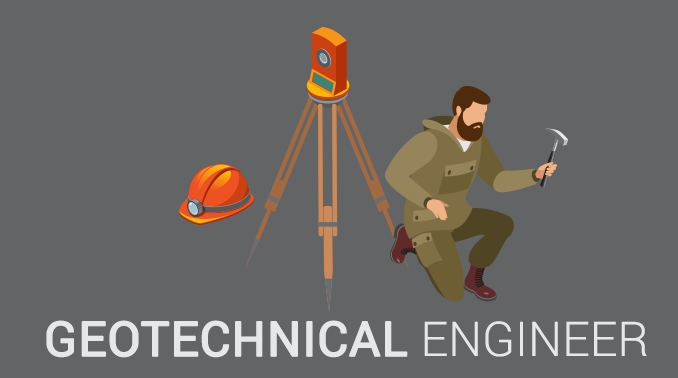8 Easy Facts About Geotheta Explained
8 Easy Facts About Geotheta Explained
Blog Article
The Best Guide To Geotheta
Table of ContentsThe Basic Principles Of Geotheta Facts About Geotheta UncoveredGeotheta for DummiesGeotheta Things To Know Before You Buy
They collaborate with civil engineers, structural designers, engineers, and various other experts to incorporate geotechnical considerations right into the total task design and building procedure. This needs effective synergy, sychronisation, and communication to ensure that the geotechnical aspects line up with the job purposes and satisfy regulatory demands.Mining & Materials Engineering: Concepts of boring, penetration rates, and elements influencing the option of exploration approach. Qualities of nitroglycerins, shooting systems and blast patterns. Blasting methods in surface and below ground functions. Unique blowing up strategies at excavation borders. Resonance and noise control. Mechanical and continual techniques to fragmentation, including longwall shearing and fullface boring.
Modelling of piece and particle size circulations; comminution as a transfer feature. Comminution modern technology: crushing, grinding, size classification. Integrated analysis of fragmentation and comminution operations. Provided by: Mining & Products Design.
Some Known Facts About Geotheta.
Bachelor's level programs in civil, geotechnical, geological, and ecological design normally last 4 years and consist of general education training courses in English, social scientific research, and the humanities, in addition to training courses in innovative mathematics, structural geology, and liquid mineralogy. (https://www.openstreetmap.org/user/geotheta)
Geotechnical design entails the evaluation of the dirt and rock problems at a specific website, and their effects for the development of that website. As most frameworks depend on the ground for assistance, it lacks surprise that a thorough understanding of the ground conditions, and the suitability of foundation systems, are crucial to the lasting stability and performance of the building or structure.
Being experts in the investigation of geological formations and ground behavior, geotechnical engineers execute clinical investigations and screening to understand the influence these geological formations may carry the style and construction of building, civil and facilities tasks. This proficiency is crucial for the design and building of buildings, roadways, tunnels, dams, bridges, and water system and sewer systems.
The geotechnical team at Douglas Allies routinely seek advice from with designers, layout engineers, developers, and home builders to make referrals on design and development proposals to make certain that the developed structures are accordingly made for the ground conditions. For instance, the style of footing systems needs to think about the weight of the structure, the capability of the ground to sustain that weight along with movement tolerances and efficient construction.
Excitement About Geotheta
This job is considerably simplified by the use of our Douglas Map geospatial platform that makes this info readily available in an easy to use internet browser user interface. A geotechnical designer will direct the drilling of boreholes and examination pits to gather dirt and various other examples, and likewise analyze surface area functions and ground exposures to form a geotechnical version of the subsurface problems.
Relying on the project type and ground conditions came across, laboratory testing might to name a few points assess strength, compressibility, reactivity and/or permeability of dirt and rock examples. After this information is gathered and collected, the results are made use of for a geotechnical design of the site, which is generally offered as areas throughout the website.

A geotechnical examination by nature can only assess the ground conditions at the places pierced or dug deep into. Natural variations in soil and rock conditions can occur throughout a site and in between test locations. It is consequently good practice that the geotechnical engineer be maintained throughout building and construction of the project to provide on-site verification that the ground problems experienced are constant with the assumptions and advice supplied in the geotechnical investigation record.
Not known Details About Geotheta
Geotechnical engineers use their in-depth knowledge of dirt and rock to evaluate threat and solve problems on diverse infrastructure projectsGeotechnical engineering is a specialist branch of civil design which checks out the behaviour of planet products and the application of soil and rock auto mechanics. Geotechnical Engineers. As a geotechnical designer, you will certainly evaluate the physical, mechanical basics and chemical properties of dirt and rock in order to develop foundations, maintaining structures and earthworks
Geotechnical design is closely linked to and overlaps with, both design geology and ground engineering - https://hearthis.at/geotheta/set/geotheta/. It's possible to specialise in geotechnics or job for a geotechnical company yet be referred to as a design geologist or a ground designer. As a geotechnical designer, you'll require to: construct and preserve partnerships with clients and various other specialists entailed in the site, throughout each projectmaintain security requirements on website be conscious of price implications when you make recommendationsstudy geological maps and airborne photographs from a variety of resources and from different time periodsexamine building intends to see exactly how viable they are based upon your understanding of the siteinvestigate risks or geological threats for the sitesearch for environmentally delicate features, such as land fill begin to develop accurate and interpretive ground modelsplan area investigationsdrill and evaluate examples of bedrock, soil, groundwater and extra products manage other experts on sitesolve technological concerns as they emerge, such as unanticipated frameworks at drill sitesmonitor conditions throughout and after building to make certain frameworks are steady in the short and long termadding information accumulated on site to your preliminary researchcreating geotechnical computations, illustrations, and 2 or three-dimensional computer system designs interpreting the datamaking suggestions about the recommended use the website

Report this page